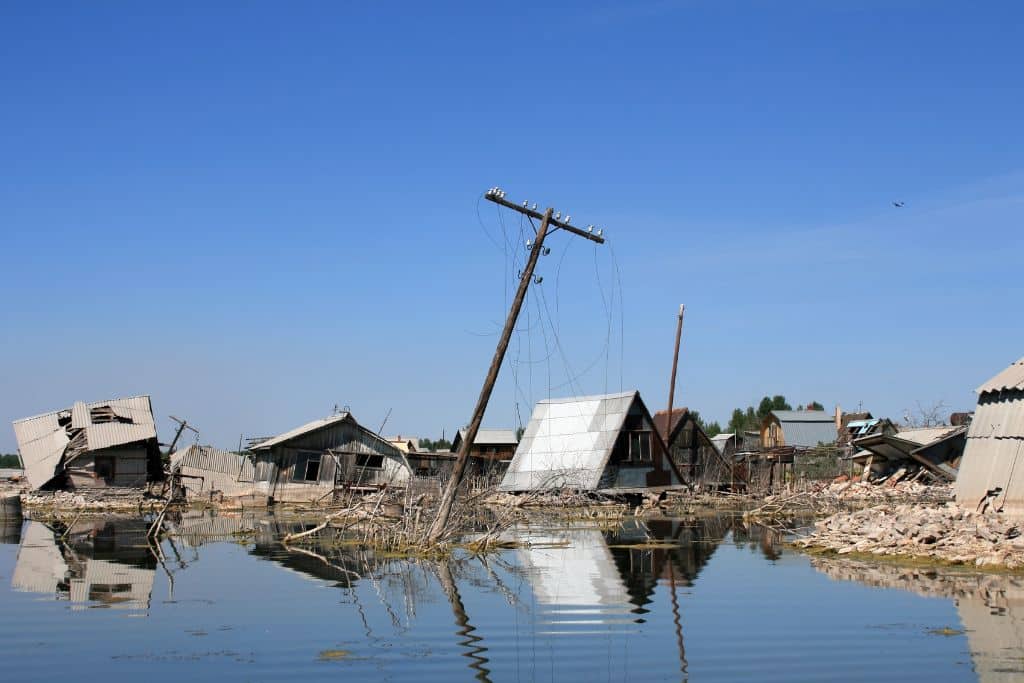Plastic pollution in the ocean is one of the biggest environmental issues of our lifetime, affecting people and ecosystems people worldwide. A new report concluded that 218 million people – about 3% of the world’s population – are at risk from plastic-aggravated flooding. Here’s why plastic pollution is causing floods, the repercussions of this phenomenon, and actions we can take to prevent it.
—
How Are Plastic Pollution and Flooding Connected?
Poor solid waste management causes plastics to get stuck in sewer drainage systems, obscuring the water flow and resulting in floods. This was the conclusion scientists came to in a recent report commissioned by Tearfund and Resource Futures. Various items can cause these blockages, including plastic bags, nylon threads, and bottles.
Poor urban areas with minimal flood alleviation infrastructure, such as sub-Saharan Africa, East Asia, and South Asia, are among the most affected. This, combined with climate change, which is often linked to heavy rainfall, can lead to flooding.
In addition to being incredibly dangerous, floods can also result in serious health diseases, including vector-borne diseases, cholera, and skin infections.
Plastic-Aggravated Flooding: Who Is Affected?
The Tearfund report outlines that 41 million of the 218 million people affected by this phenomenon are elderly, children, and disabled individuals, who are also more inclined to develop related health conditions. Plastic-aggravated flooding has affected many countries, including Indonesia, Bangladesh, India, the Democratic Republic of Congo, Ghana, Nigeria, and Cameroon.
Unfortunately, plastic’s involvement in floods is no new development. Such events have been taking place worldwide for years. In 2005, over 1,000 people were killed when poor drainage systems affected water drainage in Mumbai. Another noteworthy example of plastic-induced flooding occurred in 1988 in Bangladesh, when more than half the country was underwater.
According to the report, such events will continue to happen – especially in urban areas in Africa and Asia. It also predicts the overall number of people living in slums is expected to reach 3 billion in the next 27 years.
Is Plastic Pollution Only Getting Worse?
Plastic is such a huge problem because it takes about 1,000 years to decompose. While plastics do not break down, they can degrade in quality and turn into smaller pieces – which we commonly refer to as ‘microplastics’ – through processes such as weathering and exposure to wave action, wind abrasion, and ultraviolet radiation from sunlight. These tiny particles eventually end up in animals and even humans through the food chain, harming entire ecosystems.
Plastic Pollution in the Sea
Roughly 8-10 million metric tons of plastic enter the ocean annually. Currently, about 50-75 trillion pieces of plastic contaminate the sea. While larger sections can be removed, the same can not be said for microplastic.
Plastic pollution has severe repercussions:
- It kills marine life: Sea creatures mistakenly eat small pieces of plastic, thinking it is food, which in most cases results in them dying. Many also get tangled in large portions, such as fishing lines. This can cause serious injury and pain to the animals.
- It pollutes the air: Burned plastic pollutes the environment due to the release of chemicals that can be extremely harmful to humans and animals if inhaled.
- It causes plastic-induced floods: Plastic that gets stuck in drainage systems prevents water from passing through, resulting in floods.
- It disrupts the food chain: Plankton are living organisms eaten by marine life. Those contaminated by microplastic particles pass it on to fish and eventually to people, threatening their health.
You might also like: 10 Plastic Pollution in the Ocean Facts You Need to Know
What Can Be Done?
Communities must come together to reduce the overall amount of plastic. One of the biggest things people can do to mitigate the issue is to cut back on using plastic as well as support businesses that reduce plastic waste, as 70% of consumers believe companies bear responsibility for making the world as better place.
Here are a few things people can start doing today:
- Partner up with or opt for companies that have procedures and policies in place to safeguard the environment.
- Support organisations working on creative solutions to help remedy this matter.
- Reduce plastic consumption in your day-to-day life
- Help with beach cleanup projects.
- Buy consumables that come in recyclable packaging.
- Pick up plastic waste.
One Combined Effort
Plastic-induced floods will continue to happen until humans tackle plastic pollution head-on. Unfortunately, this issue will affect generations to come. It will take a combined community effort to reduce plastic in the environment.
You might also like: Your Guide to Recycling Plastics


















